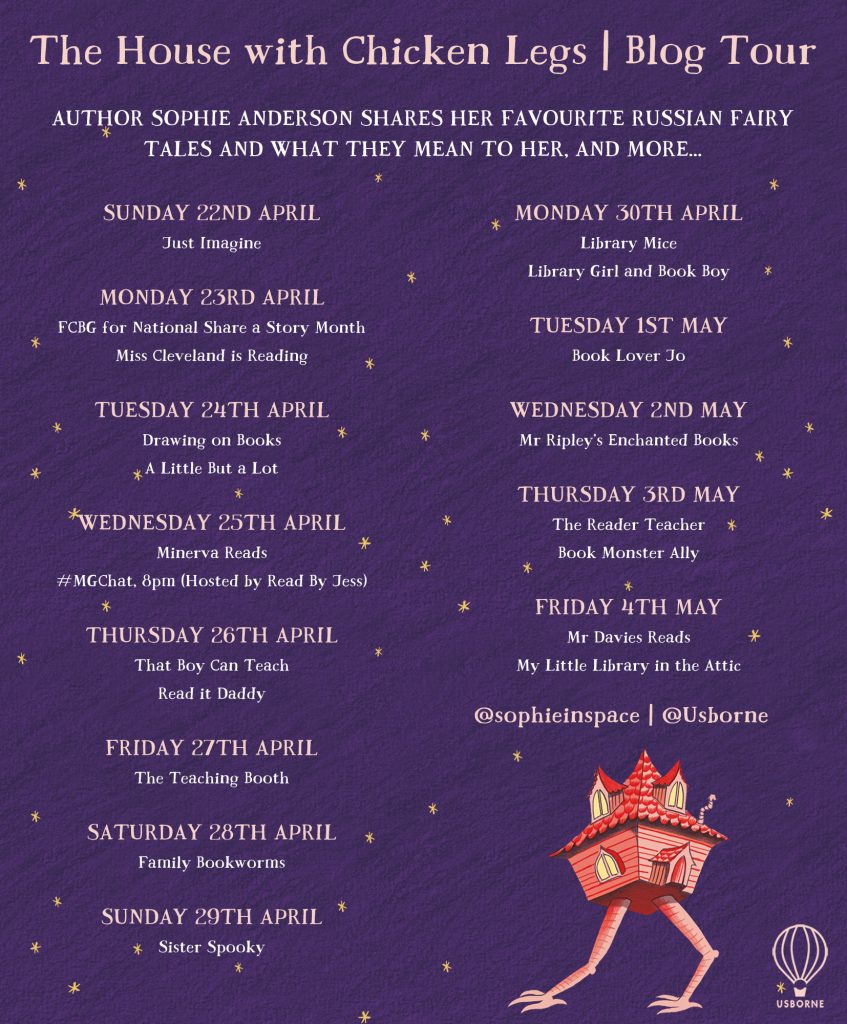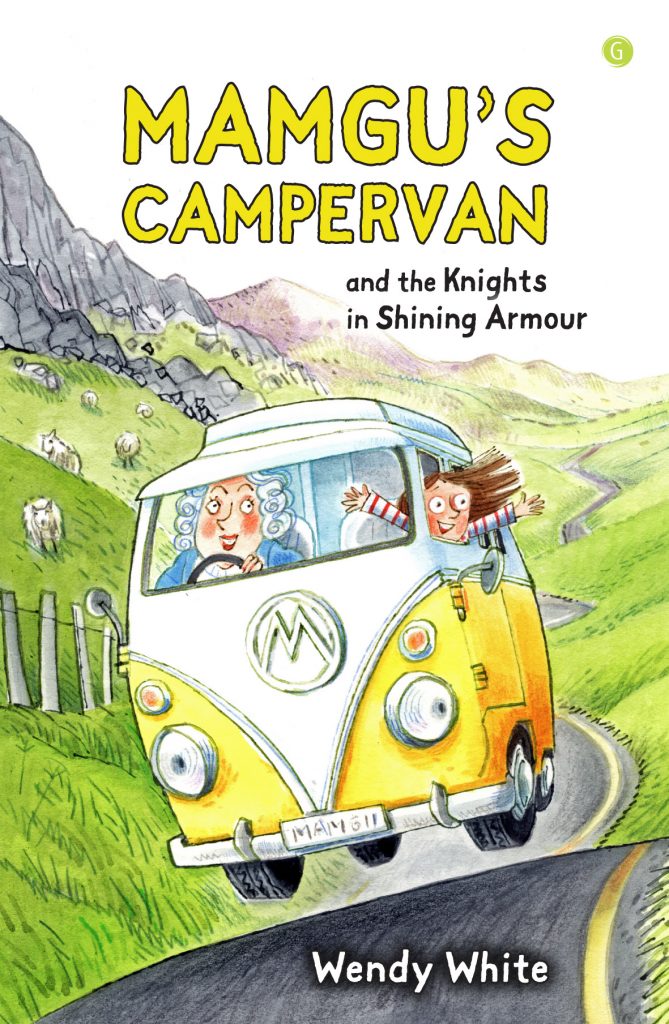Month: April 2018
HwCL Blog Tour
Sadko (On the Power of Music)
Sophie Anderson
Number 6 in a series of blog posts to mark the publication of The House with Chicken Legs
‘In Novgorod, in famous Novgorod,
There lived Sadko…’
Sadko is the main character in a Russian medieval bylina (a narrative poem or song). Sadko’s only possession was his maple gusli (a stringed instrument), but he played it so beautifully he was invited to all of Novgorod’s feasts.
One day, Sadko played his gusli on the shores of Lake Ilmen, the water began to swirl, and the Sea Tsar rose from the surface and said,
‘I don’t know what I can reward you with
For my pleasure, for my great pleasure,
For your tender playing.
Perhaps with countless golden treasure?’
The Sea Tsar tells Sadko to make a wager with all the merchants in the city that he can catch a fish with golden fins. Sadko does this, casts a net into the lake, and catches three fish with golden fins. He wins three shops of the finest goods and begins to trade and make great profits.
Sadko builds thirty scarlet ships and spends many years trading along the River Volkhov, Lake Ladoga, the Neva River, and across the blue sea. He earns barrels of gold and silver, but when he decides to return to Novgorod a storm forms in a cloudless sky and his ships stop in the middle of the sea.
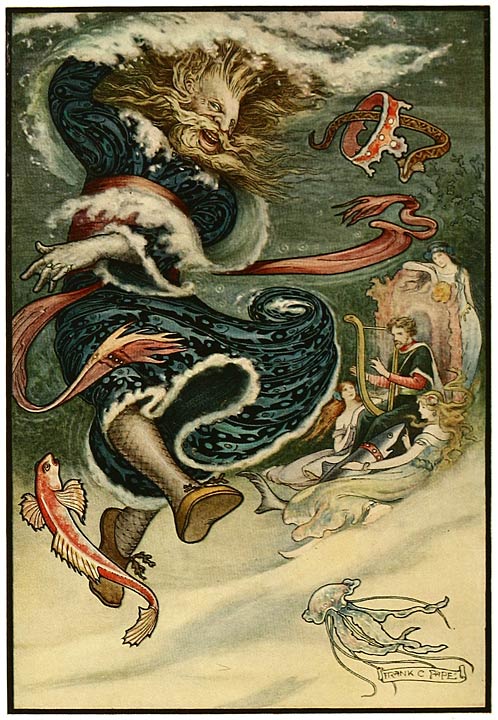
Sadko realises it is time to make a tribute to the Sea Tsar and lowers a barrel of silver into the water, but the storm continues. He lowers a barrel of gold next, but still his ships won’t move. Sadko realises the Sea Tsar needs a living tribute and asks his crew to write their names on wooden lots and cast them into the sea.
All the lots float, apart from the one with Sadko’s name on. So, Sadko takes his maple gusli and sits on a plank in the sea while his ships sail away. He falls asleep and wakes on the bottom of the sea, with the Sea Tsar’s palace before him.
The Sea Tsar asks Sadko to play his gusli as tribute, and when the music sounds the Sea Tsar begins to dance. For three days Sadko plays, unable to stop, and the Sea Tsar dances up a storm that, far above, on the surface of the sea, smashes ships and drowns sailors.
Finally, Nikola Mozhaisky (the patron saint of sailors) touches Sadko on the shoulder and tells him to break his gusli strings, so Sadko plays a chord that breaks his strings, the Sea Tsar stops dancing, and the water calms.
To reward him for his playing, the Sea Tsar asks Sadko if he would like to marry a beautiful mermaid. Under the guidance of the saint, Sadko lets hundreds of mermaids pass by, and chooses a maid at the back of the procession. Then Sadko does not sleep with her on their wedding night, as the saint tells him he will stay forever in the blue sea if he does. The next morning, Sadko wakes in his beloved city of Novgorod.
I recognise several themes in the Sadko bylina, such as paying respect to those who help you, and love of home. But to me, the story of Sadko was always about the power of music.
When Sadko had nothing else, his music nourished him; both metaphorically and literally as he was welcomed at feasts. Music made the Sea Tsar rise from Lake Ilmen and reward Sadko with riches.
Music took Sadko to the underwater realm, where he saw a great palace and many beautiful mermaids. And Sadko’s music was so powerful, it made the Sea Tsar dance up a storm.

I have always loved music. Long before we can talk or understand speech, music provides an introduction to how we communicate, how we feel and express emotions, and how we use our imaginations to create and tell stories. Music is a powerful magic, a universal language of the human soul.
And the story of Sadko has inspired more music! Nikolai Rimsky-Korsakov composed a piece of orchestral music based on Sadko in 1867, and later developed this into an opera.
A version of Sadko can be found in Old Peter’s Russian Tales, written by Arthur Ransome, published by Puffin.
Alexei Tolstoy wrote a poem, Sadko, but I have never found an English translation – so if you know of one, I’d love to hear from you!
Do check out the rest of the blog tour (see graphic at the top) – Sophie has written 15 posts about Russian Fairy Tales and what they mean to her. You can read Noah Worm’s review of The House with Chicken Legs here, and Sophie has also answered our questions here.
Author Q & A: Sophie Anderson
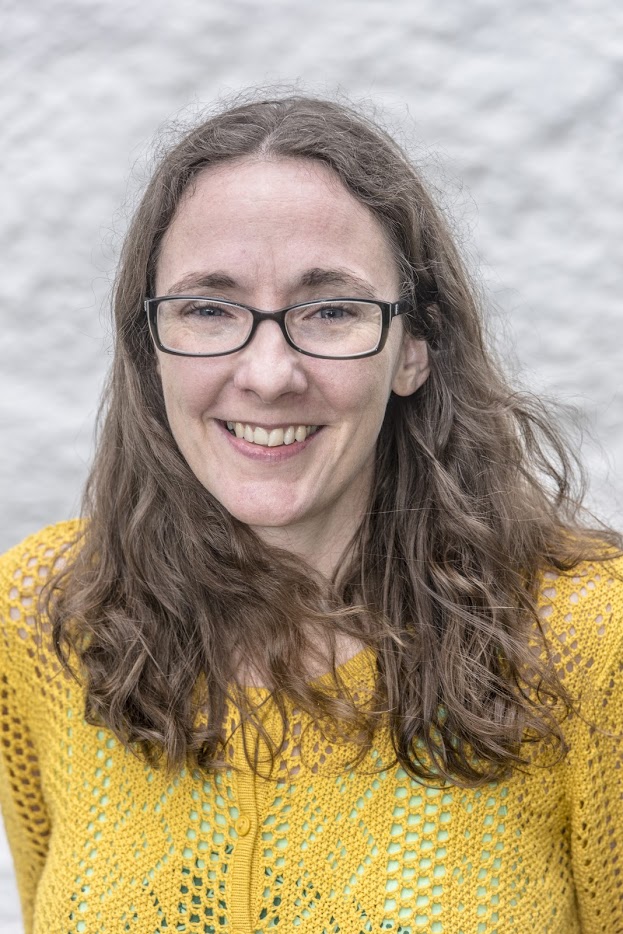
To mark our stop on the House With Chicken Legs blog tour we asked Sophie Anderson to answer these questions set by the young worms. We have previously reviewed The House with Chicken Legs and we are delighted that Sophie has also written an exclusive post for Family Bookworms.
What are you reading at the moment?
I’ve just finished The Wild Folk by Sylvia Linsteadt. It’s published on 31st May, but one of the enormous perks of being an Usborne author is getting the occasional ARC! The Wild Folk is glorious; both thrilling tale and song to the natural world. Next on my tbr pile is The Infinite Lives of Maisie Day by Christopher Edge, which I have been excited about forever!
Where and when do you write?
I home school my three children, and every day is different. Sometimes I get up before my children and write for an hour or two. Or sometimes I get a little writing done in the afternoon if my youngest has a nap, and the older two are busy with their own projects. Or sometimes I write at the end of the day, when my children have gone to bed. I don’t have an office or dedicated writing room; just a small standing desk in the corner of the living room with a laptop on it.
Who or what inspires you?
I love writing stories inspired by fairy tales, or fairy tale characters. Fairy tales can stimulate so many ‘what if?’ questions that spark new stories; they beg to be told from different points of view; or reimagined in original ways.
Which book do you wish you’d written?
The Moomin books by Tove Jansson were my first love, and I hugely admire her talent as a writer and illustrator. But I can’t wish I wrote them, because if I did, they would be something completely different! I think it’s important we all keep our unique voices, and create our own works of art, so I’m just happy to have written The House with Chicken Legs!
How long did it take you to write The House with Chicken Legs?
The first draft flowed so well, it poured out in less than two months. But then there were three months of edits with my agent, where the book went through two more drafts and nearly doubled in size. Then there were two months of structural edits with my editor at Usborne, followed by a month of copy edits, and at least another month of final tweaks. So, nine months in total. But there were around two years between writing and publishing because between each stage is some waiting time. It can feel like nothing is happening during these times, but they are actually really important stages in themselves, as they distance you from your work, enabling you to look at it with fresh eyes.
How do you choose character names?
Good question! They have to feel right for the character, and for me there always has to be a kind of hidden meaning or link. For example, there is an old folk tale I once heard where Baba Yaga has a daughter named Marinka, so that is where her name came from. Jack for a jackdaw is unimaginative I know, but it felt perfect! The Old Yaga, whose name is Tatyana, and Yaga Onekin both have names borrowed from Eugene Onekin, a novel written in verse by Alexander Pushkin. In Pushkin’s novel, Onekin and Tatyana show love for each other at different times of their lives, but never manage to get together. It isn’t mentioned in The House with Chicken Legs, but I think Yaga Tatyana and Yaga Onekin have a similar history.
Marinka is a really interesting character. Are you like Marinka at all?
Yes! I am in my forties, but I often still feel like a young girl trying to find my place in the world! Her character was also inspired by my children who, like Marinka, dream of climbing over fences and carving their own destiny. But as soon as I started writing Marinka, she became incredibly real to me and took on a life of her own!
When Marinka leaves the house to explore the world and make friends, she finds that friendship has its challenges. What makes a good friend?
Another good question! I think someone who values and respects you for who you are, and genuinely enjoys spending time with you. Someone who makes you feel happy and loved.
Would you like to live in a Yaga house?
Oh yes! I have always wanted to. I would sit on the house’s roof as it ran over fells and hills, splashed through rivers, swam across seas, and skated across ice sheets. It could grow me a vine hammock on its porch, and we could sleep together under the stars.
Can you tell us about your Welsh connections?
I was born and brought up in Swansea. My maternal grandparents lived in Pontypridd, and my paternal grandparents in Brecon. I left Swansea when I was eighteen, to go to University in Liverpool, but my parents still live in my childhood home in Swansea, and I visit them regularly.
Can you tell us something about your next book/idea/future plans?
My next book is a reimagining of another, lesser known, Russian fairy tale called The Lime Tree or Why Bears’ Paws are Like Hands; and, like The House with Chicken Legs, it is an MG novel with themes of identity and belonging. One of the minor characters from The House with Chicken Legs features with a larger role, but it is definitely another stand alone novel.
If you weren’t an author what would you do?
I think I would have to express my creativity in other ways. Maybe puppetry! A giant marionette House with Chicken Legs would be awesome!
We’d like to sincerely thank Sophie for taking the time to answer our questions. She has also written a brilliant blog post just for us on Sadko – a character from a narrative poem and an opera by Rimsky-Korsakov.
Author Q & A: Christopher Edge
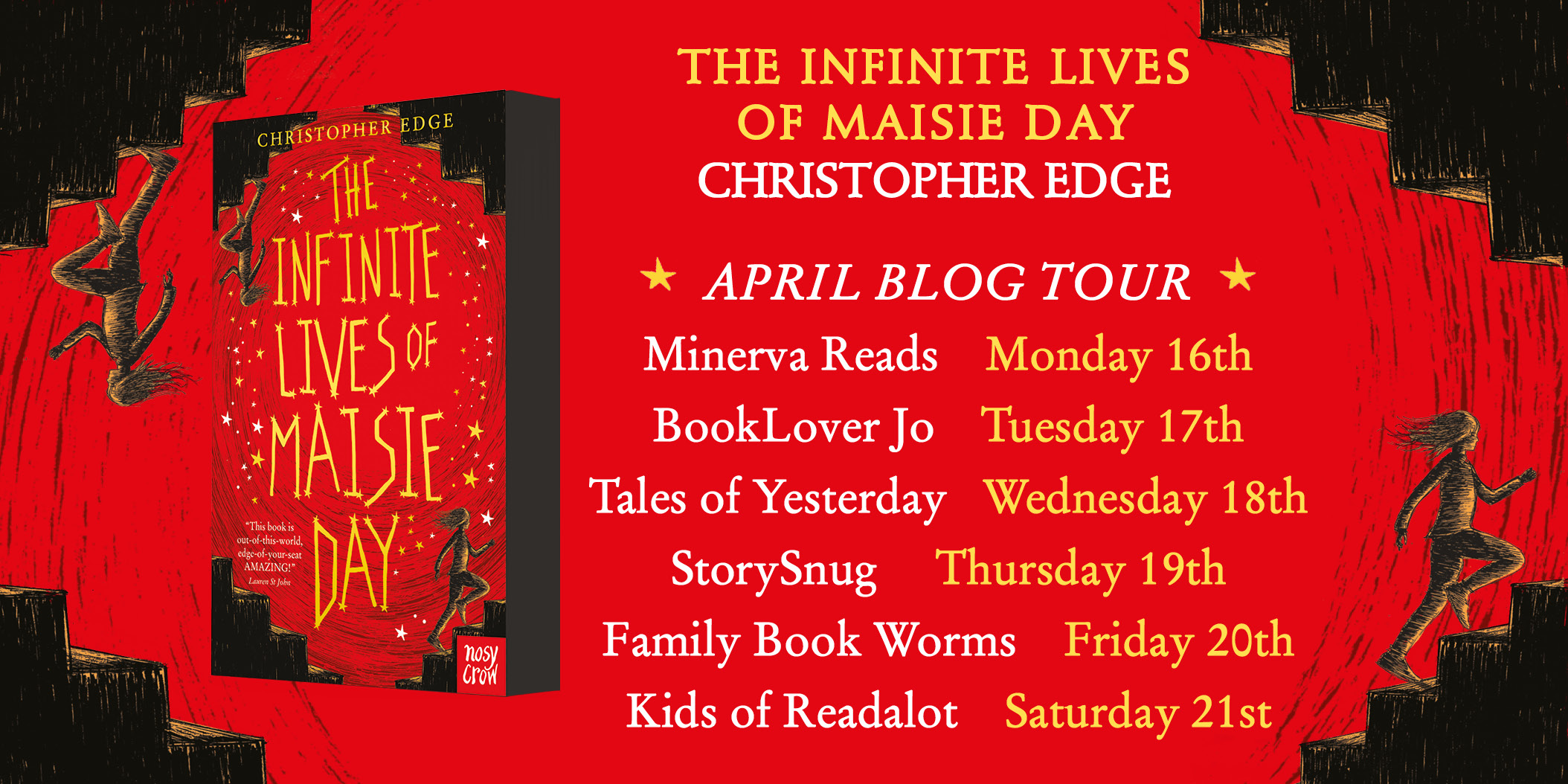
We are absolutely thrilled to be part of this astronomical blog tour and are delighted that Christopher Edge has answered some questions set by the young worms. You can read our review of The Infinite Lives of Maisie Day now or later.
What are you reading at the moment?
I’ve just finished reading Daemon Voices, a wonderful collection of essays from Philip Pullman on the art of storytelling. I always read in bed at night before I go to sleep, so for the past few weeks I feel as though I’ve been having some rather intense late-night discussions with Philip Pullman!
Could you tell us how you got into writing?
I’ve been writing stories since I first learned how to write, although publication came much later. Following a short-lived career in teaching, I made the move into educational publishing and there had a role reading some of the best contemporary children’s literature being published with a view to discovering novels that teachers might want to use in the classroom. Reading books by authors such as Frank Cottrell Boyce, Sonya Hartnett and Philip Reeve showed me the brilliance and ambition of the stories being told in children’s fiction and made me want to write my own, which I then started doing on the commute to and from work. After a couple of unpublishable novels that are still locked away in a drawer somewhere, I wrote the story that found me my agent, and then a publisher and so finally realized my dream.
Do you miss teaching?
As you might have guessed from my description of my short-lived teaching career, the answer is no! I was waylaid into teaching by the film Dead Poets Society and misled into believing that all you needed to do to be a great teacher was inspire students to stand on desks declaiming poetry.
Where and when do you write?
In the best tradition of Roald Dahl and Charles Dickens I have an office at the bottom of my garden that I retreat to. When I’m writing the first draft of a story I like to immerse myself in this writing full-time, but other times I’ll be travelling to events with a notebook handy so I can keep scribbling away on the move. I actually think I do some of my best writing on trains, so would quite like to be hired as the writer-in-residence on Great Western Railways.
You have written several books for budding authors. What is the most important piece of advice you have on this?
Every writer is a reader and every reader can be a writer too. Fill yourself with stories and I believe your own will start tumbling out.
Which books and authors inspire you?
Too many to mention! Every book I’ve ever read feeds the roots of the tree my stories grow from. Many years ago, bunking off school to get my comics signed my Neil Gaiman inspired me to dream that one day I could be a writer and I’ve blogged about this here.
How do you choose names for your characters?
For me, every story starts with a character and they seem to come to me with a name attached. For The Infinite Lives of Maisie Day I had an image of a girl opening her front door to find an infinite blackness outside and the moment this image came into my mind, I knew this girl’s name was Maisie.
Do you have any connection with Wales?
I’ve walked the whistling sands on the Llyn Peninsula, visited Conwy Castle as a child, but think my strongest connection to Wales is my love of the Super Furry Animals!
You’re clearly interested in Science. Where did this interest come from?
I didn’t enjoy science at school, but as I’ve got older my interest in science has grown. Watching documentaries made by scientists such as Carl Sagan and Professor Brian Cox make me marvel at the sheer wonder of the Universe, and I now find myself picking up books by popular science writers such as Brian Clegg and Carlo Rovelli to read for pleasure!
Your most recent books have been full of scientific ideas but there is often an emotional human story at the heart. Is this a fair assessment, and do you see either as more important?
I think both science and stories approach the same questions from different angles. Why are we here? What makes us human? How do we know we really exist? Both science and fiction help us to make sense of the world, with all its wonder and possibilities as well as its inevitable pain. In my books I hope to use scientific ideas to explore the human condition and tell stories about love, loss and family. Without heart, the story would be a lifeless thing.
 You have a Spotify playlist for Jamie Drake. Are you planning one for Maisy Day? If so, what would be your top choices?
You have a Spotify playlist for Jamie Drake. Are you planning one for Maisy Day? If so, what would be your top choices?
Yes, there is a soundtrack for The Infinite Lives of Maisie Day – actually there’re two! As well as my own chapter-by-chapter soundtrack for the book, there’s also a soundtrack that’s been curated by BBC Radio DJ Chris Hawkins of the songs the story reminded him of. And the one song that made it onto both soundtracks is the mesmerizing ‘Birthday’ by The Sugarcubes, whose queasy beauty sets the scene in my mind for the opening chapter of the story. (For more on this visit the Nosy Crow blog).
We love the covers by Matt Saunders. How much involvement do you have with this and how important is it for you that the cover somehow reflects your writing?
I love Matt’s cover art too and the brilliant design that Nosy Crow create for my books. I’m very lucky in the fact that I’m allowed to comment on the cover concepts and designs as these are developed, and feel incredibly proud that the first contact a reader might have with my books comes via Matt’s cover art as I love the way my stories are represented by his artwork.
Can you reveal anything about what you’re working on at the moment?
I’m writing a new novel at the moment which should hopefully be published in Spring 2019. I can’t say too much about it at the moment, but it’s about friendship and what it means to be alive.
What question do you wish we’d asked?
I’m just glad you didn’t ask me to explain infinity!
Thank you so much to Christopher Edge for indulging us. Did you know he came with us to Scotland? Read our review now.
The Infinite Lives of Maisie Day

The Infinite Lives of Maisie Day
Christopher Edge
Nosy Crow
Review by Noah (age 10) with Mummy Worm
Terrifying and terrific science educates as much as it entertains.
A few weeks ago we took Christopher Edge on a very long car journey. It was one of the most interesting car journeys we’ve ever been on – one which expanded our minds and took us to other dimensions. We’d heard so much about his ‘science’ novels, and the Albie Bright audiobook was out-of-this-world amazing. Imagine our keenness and delight, when we were invited to review Edge’s new story, The Infinite Lives of Maisie Day.
10 year old Noah was drawn in by the ‘familiar world’ story of gifted Maisie, also 10, struggling to make sense of her relationship with her big sister. He was more fascinated by the terrifying science bits and keen to share his new found understanding of “dark matter” with his confused Mother (who decided to read the book for herself to understand what her very intelligent-sounding son was going on about!) Mum enjoyed feeling (temporarily) super-intelligent too and anticipates some impressed stares from her Mummy friends as she and Noah discuss the authenticity of the plot’s ability to anchor familiarity in its setting, whilst at the same time enabling the space-time distortion to feel weirdly authentic.
There comes a point in the story, a very powerful and crucial point, where the mystery begins to unravel and things start to change, heading towards a resolution – this is Noah’s favourite part. The vivid descriptions of optical illusions such as Escher’s never ending staircase chill as much as they thrill. The alternate universe and the superb and frighteningly convincing explanation of events make this a unique book from a unique author – Noah has never read anything like it, nor has Mum, hence its huge appeal. This really is a book you must pick up and you won’t want to put down.
With its challenging concept, engaging plot, endearing narrator and satisfying conclusion, The Infinite Lives of Maisie Day is a “boss read”. Noah would recommend it especially to anyone in Year 6 or Year 7 who enjoys thrilling heavenly stories!
Thanks to Nosy Crow for sending a copy of The Infinite Lives of Maisie Day. You can buy it from Hive or better still, from your local bookshop.
You can follow Christopher Edge on Twitter, as well as Matt Saunders who designed the cover.
We were part of the Maisie Day Blog Tour – you can read a Q and A with Christopher here.
Mamgu’s Camper Van
Mamgu’s Camper Van and the Knights in Shining Armour
Wendy White
Gomer Press
A charming short story from the writer of St David’s Day is Cancelled
Review by Nina (Age 8)
St David’s Day is Cancelled is my favourite book. Ever. So I was really happy when I heard that Wendy White had written a new book. Mamgu’s Camper Van is lots of fun; it’s short and I read it in an hour.
Mamgu and Betsi Wyn get the camper van out of hibernation but it doesn’t seem to be working properly! They finally get it going and take it out for a spin to a castle. It’s a heartwarming adventure story that children in Year 2 and Year 3 will love. I think Mum should read it to Kit (my little brother), because he would love it too.
I really liked all the Welsh words that Wendy White used – castell, diolch, da iawn, Ych a fi! – it gave the book a definite Welsh feel! I also loved the pictures: Helen Flook’s illustrations made the story come to life – the colourful front cover is especially good.
I would recommend this book for children up to 8 years old and am looking forward to reading more by Wendy White soon.
Thanks to Gwasg Gomer for sending us a copy of Mamgu’s Camper Van. You can buy it direct from Gomer or, from your local bookshop.
You can follow Wendy White on Twitter, as well as the illustrator Helen Flook.
A Whisper of Horses
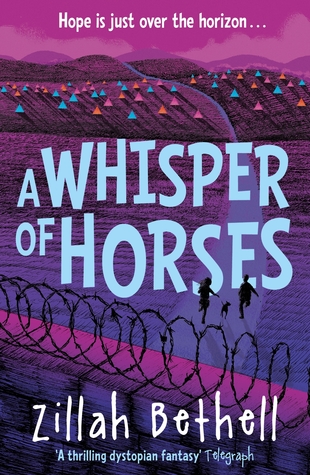
A Whisper of Horses
Zillah Bethell
Piccadilly Press
Reviewed by Simon (Daddy Worm)
Last year, I fell head over heels in love with The Extraordinary Colours of Auden Dare, Zillah Bethell’s second MG-flavoured book with Piccadilly Press. Bethell is a master of storytelling; her narrative style is effortless; the plot lines are inventive and clever; her characters feel so authentic they could be members of your extended family. A Whisper of Horses was her first novel for children and was given a paperback release in January.
At this moment in time, it’s not possible for me to like another book more than Auden Dare, but A Whisper of Horses is another fantastic read. Similar to Auden Dare, it’s also set in the future. I’m not sure if Bethell approves of her books being called “dystopian” (adj. relating to or denoting an imagined place or state in which everything is unpleasant or bad, typically a totalitarian or environmentally degraded one); I believe in America they refer to them as “futuristic adventure fantasy” – possibly a more fitting description although Bethell’s imagined future is run by a controlling government adept in propaganda. The future in ‘Horses’ is certainly environmentally degraded: there have been big changes in the landscapes caused by poisonous gases – the sky is a different colour and many indigenous plants have been killed. The language has evolved too – the names of places mutated into strange phonetic versions of towns, cities, rivers and landmarks we think we know. Serendipity, our main character, lives in the walled city of Lahn Dan where a caste system is strictly enforced and controlled by The Ministry.
Before her mother died, Seren was given a clue to the existence of horses (thought now to be extinct) and she vows to escape the city and embark on a quest across ‘Grey Britain’ in search of these beautiful and elusive creatures. The now clichéd quote from Arthur Ashe about the journey being more important than the destination rings true as Serendipity’s road-trip brings new friends, learning, peril, understanding, resilience, realisation. And these virtues are bestowed on the reader too as one finds oneself questioning society, class, the role of technology and democracy. This is not a journey without danger – this is a pursuit as Serendipity is hunted by the lawmakers who are desperate to stop her from achieving her goal – but why?
A Whisper of Horses is a thoroughly enjoyable read with an enthralling story and one that makes you ponder and contemplate too. I particularly enjoyed the relationships in Auden Dare and the same is true here – Seren’s friendship with Tab, her companion on the journey, is rich and warm and discerning.
So this seems to be no cure for my Zillah Bethell fascination (bethellitis?), and I’ve left it some time before posting this review to be sure that I’m compos mentis. Bethell is such a glorious writer I want to stand on top of my space-age pod-home and shout it out to this oppressed and inhumane world.
Thanks to Zillah for sending a copy of A Whisper of Horses. You can buy it from Hive or better still, from your local bookshop.
You can follow Zillah Bethell on Twitter, as well as Matt Saunders who designed the cover shown.
Storm Wake
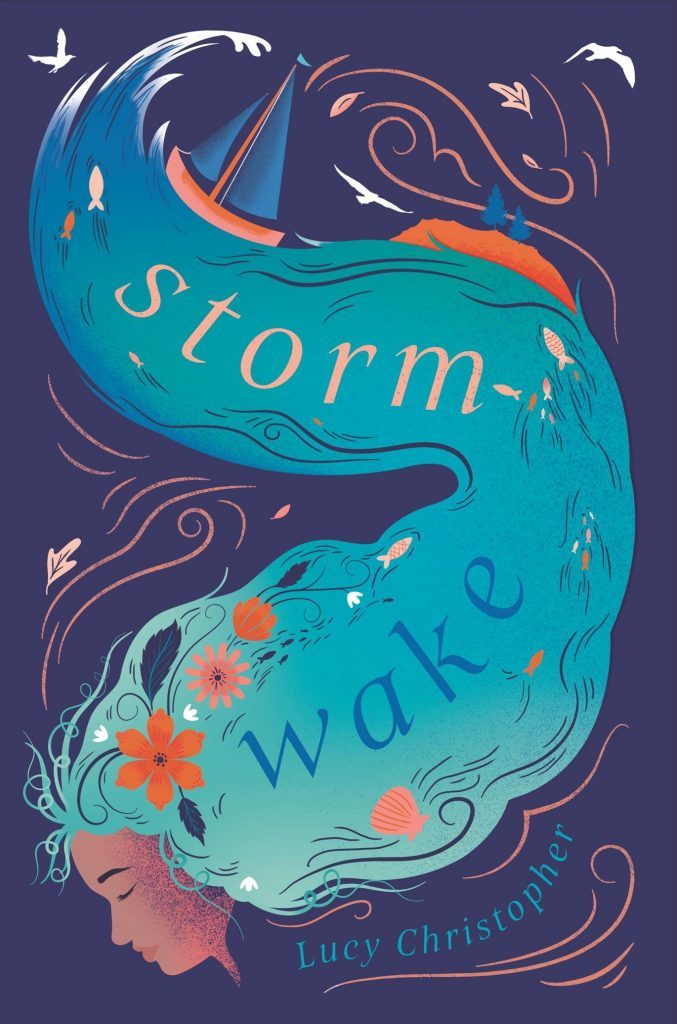
Storm-Wake
Lucy Christopher
Chicken House
Reviewed by Mummy Worm
For me, reading is escapism. The world around disappears and I’m immersed in the world created by the author. It took a few pages longer than usual to sink into Lucy Christopher’s Storm-Wake but this is no criticism. The lyrical phraseology sparked more curiosity and my attention was held by the language as much as the narrative. Storm-Wake is a visceral experience. It is nothing short of magic when you smell, taste, see the hallucinogenic effects of the island’s stormflowers!
Delightful homage to Shakespeare’s Tempest rolls in and out of Christopher’s novel. I enjoyed the reimagining of Miranda as Moss, especially her relationship with bewitched Callan and the island (which is as alive as its inhabitants). Pa was an equally fascinating reimagining of Prospero. Moss’ battle with whether to admire and love, or resent and fear the man who raised her, grounds her transformation from compliant little girl to questioning teenager most effectively. Secrets, mysteries and magic spiral through each page of narrative but the familiar detail of the modern world and the brutal reality of Moss’ early childhood – and eventually the arrival of the two boys – reveal that the dream-like island is a trap and not a refuge. Escape will be far from easy.
So I “cried to dream again” after finishing Storm-Wake and anticipate further readings will enchant as much as the first.
Storm-Wake is Lucy Christopher’s fourth novel published with Chicken House. Born in Wales, but widely-travelled, she lives in Cardiff and is Senior Lecturer on the MA in Writing for Young People course at Bath Spa University. She is a Branford Boase Award winner and has been shortlisted for the Costa and Waterstones Book prizes. You can follow Lucy on Twitter and find more information at her website.
We are extremely grateful to Lucy for the copy of Storm-Wake which was given in exchange for this review. You can buy Storm-Wake on Hive, or better still, at your local independent bookshop.
The House with Chicken Legs

The House with Chicken Legs
Sophie Anderson
Usborne
My house has chicken legs. Two or three times a year, without warning, it stands up in the middle of the night and walks away from where we’ve been living.
The House with Chicken Legs has been garnering lots of praise since proof copies found its way into the hands of readers just before Christmas. Booklover Jo called it “the most accomplished debut”, whilst The Bookseller described it as “utterly magical and highly original” and countless enthusiastic authors including Claire Fayers, Stephanie Burgis and Kiran Millwood Hargrave have used words such as “spellbinding”, “beautiful” and “full of heart”.
How wonderful to come home to this delightfully presented packet. Looking forward to sharing with Noah Worm. Thanks so much! pic.twitter.com/onWi966QPz
— 🏴familybookworms🏴 (@bookwormswales) December 13, 2017
So can 10 year old Noah add any superlatives to the list? Well he’d like to start with “fascinating, gripping and really cool!” At the heart of his fascination is the Chicken House itself, borne of the Russian folktale of Baba Yaga but reimagined for the 21st Century. The Yaga House is a house that can walk, changing location whenever it wants to, without warning. Noah tells me it can also grow things – “really cool” does this justice! The Yaga House has a purpose though – it holds the gate through which the dead must walk in order to complete the circle of life. Baba Yaga, our heroine’s grandmother, makes food for the dead to give them a good sendoff.
This lifestyle is far from ideal for Marinka, a complex lead character who comes across as bold and daring but has insecurities. She feels like she’s trapped in the house with no future and no friends; she has no opportunities to build relationships or put down roots because the house keeps moving on. But she is destined to be a Yaga herself and is struggling to accept this destiny. The rebellion of youth does not sit well with this transient life.
Swansea-raised Anderson has written a lyrical and emotional debut; rooted in folklore but completely contemporary. As Marinka struggles with the circle of her own life, we get to explore human themes of friendship, purpose, contentment, life and death. Noah says “It sounds like it’s going to be a gloomy book about death but actually it’s not – you can really empathise with Marinka.”
The book should be in shops come May 3rd and if Sophie Anderson is interested in more praise, then she should know that Noah has placed The House with Chicken Legs next to Sky Song (Abi Elphinstone) in his top reads of 2018 so far.
Thank you to Usborne for providing a review copy of the book in exchange for this review.
You can buy The House with Chicken Legs from Hive or better still, from your local bookshop.
Follow Sophie Anderson on Twitter or visit her website which includes some super resources to go with the book.
